The Raising Up of Fr. De Smet
Miss Erica Kauffman
|
On January 9,2003, 130 years after his burial, the remains of Fr. Pierre Jean De Smet, S.J., were removed from their place of repose in St. Stanislaus Seminary Cemetery, Hazelwood, Missouri.
|
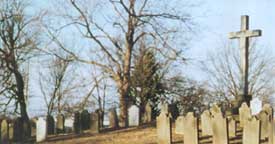
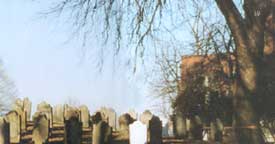
After 46 years of priestly service among the pioneers and Native Americans, Father died on May 23, 1873, the Feast of the Ascension, and was laid to rest there to await the General Resurrection. According to the eyewitness account of the Jesuit Provincial of the time, Fr. Frank Reale, who oversaw the exhumations, all that remained of Fr. De Smet were pieces of his skull and leg bone (as reported in the St. Louis Post-Dispatch, January 1, 2003). His scanty remains were since re-interred in Calvary Cemetery, Section 33, along with the ten other "historic" Jesuit figures who were originally buried alongside him at St. Stanislaus Seminary. The Province intends to erect a monument there that will include a statue of St. Ignatius of Loyola and portions of the original tombstones of these 11 missionaries. The remains of the 110 "non-historic" figures will be re-interred in a mass grave, also in Section 33, marked by a large plaque bearing their names.
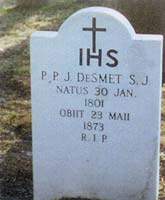 |
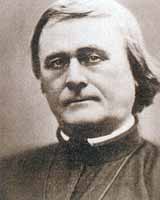 |
St. Stanislaus began as an Indian school established by the Jesuits when they first arrived in Missouri in 1823. The seminary they founded 17 years later became the home of the missionaries and the place from which they began their journeys into Indian country. Long after the missionaries' work was completed, St. Stanislaus Seminary remained a virtually self-contained city, a 999-acre community unto itself. It had its own vineyard and orchards as well as its own winery and butcher shop. In fact, until 1971 the seminary grounds were also the burial place for Jesuits from the entire Missouri Province.
In that year, the Jesuits sold the campus to the United Pentecostal Church International. The remains of the 351 Jesuits buried there were exhumed and moved to Calvary Cemetery. The oldest grave site, however, located on top of what was once an Indian burial mound, was left untouched. That grave site contained 121 bodies, and the most recent interment occurred in 1898. The cemetery, therefore, outlasted the seminary as did a museum on the property, an historic rock building built in 1840. When the Jesuits decided to move the artifacts to a new museum on the St. Louis University campus, the lay board of the museum objected, and a legal contest ensued which the Jesuits ultimately won. In addition to closing the museum, the order decided to move the remains of the pioneer Jesuits to Calvary Cemetery.1
How many are the priests who owe their vocations to Fr. De Smet? Had his great thirst for souls not compelled him to venture into the wilderness territories of their ancestors, they might never have known the Catholic Faith at all. How many faithful can trace their spiritual lineage in some way to Fr. De Smet? How many have passed through the halls of St. Louis University where the saintly priest performed his most self-sacrificing duties behind a desk? The very presence in Missouri of the Society of Jesus can be attributed to Fr. Pierre De Smet. Although America was never Catholic in the sense that we understand the countries of Catholic Europe, there is a surprising amount of Catholic history here in its heartland. This fact is especially evident in St. Louis, Missouri which was Fr. De Smet's home while he undertook mission circuits of some 200,000 miles by foot, mule, or boat, and even by 19 ocean-crossings. The secret to his sanctity was his courage, perseverance, self-abnegation, patience, and thirst for souls. How often we are discouraged from keeping the Faith in the wilderness of modern life! Let us consider instead the struggles of those brave missionaries who forged the spiritual paths for us to follow. Were their sacrifices any less difficult than ours?
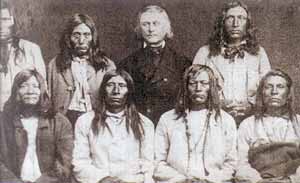
Fr. De Smet with Indian chiefs
Many great things have been written about Fr. De Smet, and it would be superfluous to repeat them all here.1 He loved both the Indians and the pioneers. Moreover, he loved Mother Church enough to empty himself to nourish Her children. Fr. De Smet was never idle. Even while he was in St. Louis resting between missions and mendicant tours, he labored in the vineyard of downtown St. Louis. Considering the influence he had on St. Louis University from his arrival there in 1823, it is appropriate that artifacts from the St. Stanislaus Mission House have been transferred to the university where he once served as treasurer for the university and the Province. From Belgium in 1832, he made arrangements for the acquisition of numerous items to be sent to the university. Probably most noteworthy among these were hundreds of books for its new library, most of which were acquired from a closed Augustinian monastery.
Before stopping at the grave site of Fr. De Smet in Hazelwood, I visited the shrine of his confidante and missionary Sister in Christ, St. Rose Philippine Duchesne, to pray in petition and thanksgiving for the intentions that called me there. Mother Duchesne founded the first Sacred Heart School in America in St. Charles, Missouri (1818) at age 49. Pierre Jean De Smet was only 17 years old and had just received his call to the priesthood. He would later enter the Jesuit seminary in Belgium at 18. Three years later he volunteered to go to America to convert the Indians. He completed his novitiate in Whitemarsh, Maryland and traveled to Florissant, Missouri, then a budding pioneer town. In 1819 Mother Duchesne established a novitiate for the Sisters of the Sacred Heart and a school for pioneer and Indian girls in St. Ferdinand parish, which began as a log cabin church in 1789. In 1821 the log cabin was demolished. (The convent wing built by Mother Duchesne still stands today.) It was in the new church that Jean Pierre De Smet was ordained to the priesthood in 1827.
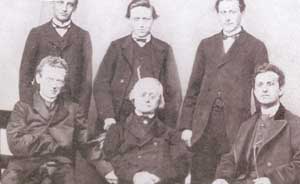
Fr. De Smet's priest-recruits from Europe (1872)
St. Ferdinand's is no longer an active parish but serves instead as a shrine. Mass is still offered there on the feast day of Mother Duchesne and on other special occasions. Since 1960, the property has been maintained by the Friends of Old St. Ferdinand's which makes tours available to the public. The high altar remains intact with altar cards and a Tridentine Missal, although the Blessed Sacrament is no longer reserved there. The paintings on either side of the altar are believed to have been brought from Europe by Fr. De Smet. The sanctuary lamp was a gift from the Bishop of Louisiana and the Floridas in 1799. Encasing his relics is the wax figure of St. Valentine, laid to rest in a glass case in the altar. These relics were a gift from the King of France to Bishop Louis Valentine Du Bourg, the bishop responsible for calling Mother Duchesne and Fr. De Smet to the missions. The 12 golden crosses on the church's interior walls are evidence of the consecration of St. Ferdinand's by Bishop Rosati in 1832.
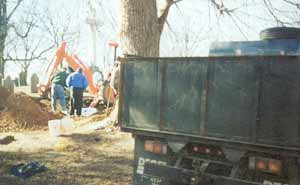
The exhumation of Fr De Smet's remains
Mother left St. Ferdinand's in 1840 to look after the other schools she had established in St. Louis and to begin her missionary labors among the Potawatomi Indians in Sugar Creek, Kansas. The religious of the Sacred Heart departed the property six years later, turning over the apostolate to the Sisters of Loretto. In her later years, Mother Duchesne performed the menial labor required to maintain the schools and convents, considering herself a failure in education because she never learned English. In her later years, she spent most of her time in prayer and was nicknamed, "kwah-kah-kum-ad" "Woman Who Prays Always." There is a little closet beneath the first floor stairway of the St. Ferdinand Convent that was her preferred cell, where she could feel close to her Divine Spouse in the Blessed Sacrament which was reserved on the other side of the closet wall. Straw was laid for her bed, but she favored spending the nights on her knees. Folded papers are tucked behind the picture and crucifix (not originals) and in crevices between the wood boards, bearing the handwritten intentions of pilgrims who still revere this as a holy place.
Fr. De Smet was confident of her sanctity and her arrival in Heaven. On the day of her death, November 18, 1852, she interceded for him. The details of this intervention have never been made public. What we do know is that the two missionaries had made a pact: the first to die would intercede for the other. He was not present at her death or burial, but 20 years later he wrote:
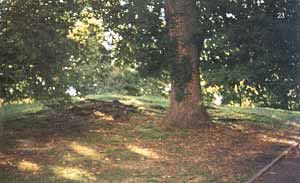
The exhumation of Fr. De Smet's remains –
The aftermath of the terrorism
I keep the memory of Mere Duchesne in the highest respect and veneration....On every return from my Indian missionary visits, I deemed it a most agreeable duty to pay my respects to good Mother Duchesne, and I never returned from one of these visits but with an increase of edification, with a full conviction that I had conversed with a truly living saint. I always considered Mother Duchesne as the greatest protectress of our Indian missions. For years she offered two Communions a week and daily prayers for the conversion of the Indians. She loved these poor, benighted children dearly and nothing seemed to make her happier than to hear of their conversions, of their fervor and zeal in the practice of their religious duties after having entered the true fold of our Divine Redeemer. I entertain no doubt, many were brought over to the Holy Faith of Christ by the many acts of mortification she performed, and by the constant prayers she offered up for the salvation of these, her dearly beloved Indian children....2
Three months before her death, Mother Duchesne wrote to Fr. De Smet, "If God is merciful to me, you will have a large share in my prayers. I beg your blessing, and I am your humble servant."3
Mother Duchesne's remains are in a marble sarcophagus in St. Charles, Missouri. Above her body hangs the crucifix from her first monastery in Grenoble, France where she was a Daughter of the Visitation, having been inspired by St. Margaret-Mary Alacoque.
One can only imagine the holy conversations between Fr. De Smet and Mother Duchesne regarding their common interest in souls and the spiritual motive that binds those consecrated to God and to each other in the Mystical Body. Throughout the centuries, as men have depended upon the prayers and penances of holy women (Our Lady being the Holy Woman) to bring forth fruit in their apostolates, so there are many cases of supernatural friendships such as these: SS. John of the Cross and Teresa of Avila, SS. Claude de la Columbiere and Margaret Mary Alacoque, SS. Francis de Sales and Jean Frances de Chantal, SS. Francis of Assisi and Clare.
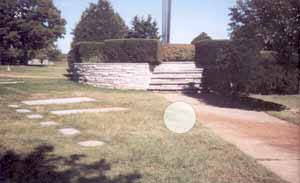
The unmarked site of Fr, De Smet's re-interred remains
At the St. Stanislaus grave site in Hazelwood, I discovered quite by chance the unannounced exhumation fully underway. Having won the difficult legal battle against the lay board, the Province proceeded without ceremony or apparent reverence for holy things. Present were a backhoe, two cemetery workers, the cemetery director, an older diocesan priest, Fr. Reale, and another Jesuit.
Nearly a year later the transfer is complete, but there are still no markers present at Calvary Cemetery where all 121 bodies were re-interred. In fact, the earth at Calvary seems little disturbed. Even the mass grave is not readily apparent. I actually walked back and forth over Fr. De Smet's grave as I went searching for him, feeling very much like Mary Magdalene after the resurrection of Christ: "Where have you laid him?" Calvary's Director of Cemeteries kindly laid out for me the scheme for the monument–a "Vietnam Memorial" style wall bearing the names of those buried in Jesuit Section 33. The Hazelwood site is now just a scarred mound.
May we pray to Mother Duchesne that she may intercede once more for her friend, that soon, on some future May 23, prayers may be offered at the altar of God in the name of St. Pierre Jean De Smet, to whom we owe so much. "Os justi meditabitur sapientiam, et lingua ejus loquetur judicium; lex Dei ejus in corde ipsius" i.e., "The mouth of the just shall meditate wisdom, and his tongue shall speak judgment: the law of his God is in his heart" (from the Introit of the Common of a Confessor). Perhaps then those responsible for caring for these holy remains will at last mark the site where those of Fr. De Smet lay.
The author and photographer, Miss Erica Kauffman, attends the Latin Mass at St. Vincent de Paul Catholic Church in Kansas City, Missouri, and has a special devotion to St. Philippine Duchesne. Information regarding the location of Fr. De Smet's grave and St. Ferdinand's Shrine is available by writing to The Angelus. Please include a self-addressed, stamped envelope with your inquiry.
1. Bill McClellan, from The St. Louis Post Dispatch, January 10, 2003.
2. Lucylle H. Evans, Black Robe: The Life of Pierre-Jean De Smet; St. Mary's in the Rocky Mountains (Doubleday & Co), and, Fr. E. Laveille, S.J., The Life of Father De Smet, S.J. (TAN Books and Publishers).
3. Louise Callan, Philippine Duchesne, Frontier Missionary of the Sacred Heart (Westminster, MD: The Newman Press), p. 462.
